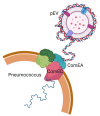This is a preprint.
Pneumococcal Extracellular Vesicles Mediate Horizontal Gene Transfer via the Transformation Machinery
- PMID: 38168155
- PMCID: PMC10760141
- DOI: 10.1101/2023.12.15.571797
Pneumococcal Extracellular Vesicles Mediate Horizontal Gene Transfer via the Transformation Machinery
Update in
-
Pneumococcal extracellular vesicles mediate horizontal gene transfer via the transformation machinery.mSphere. 2024 Dec 19;9(12):e0072724. doi: 10.1128/msphere.00727-24. Epub 2024 Nov 6. mSphere. 2024. PMID: 39503503 Free PMC article.
Abstract
Bacterial cells secrete extracellular vesicles (EVs), the function of which is a matter of intense investigation. Here, we show that the EVs secreted by the human pathogen Streptococcus pneumoniae (pneumococcus) are associated with bacterial DNA on their surface and can deliver this DNA to the transformation machinery of competent cells. These findings suggest that EVs contribute to gene transfer in Gram-positive bacteria, and in doing so, may promote the spread of drug resistance genes in the population.
Keywords: Extracellular vesicle; Streptococcus pneumoniae; antibiotic resistance; competence; horizontal gene transfer; transformation.
Figures



References
-
- Donati C, Hiller NL, Tettelin H, Muzzi A, Croucher NJ, Angiuoli SV, Oggioni M, Dunning Hotopp JC, Hu FZ, Riley DR, Covacci A, Mitchell TJ, Bentley SD, Kilian M, Ehrlich GD, Rappuoli R, Moxon ER, Masignani V. 2010. Structure and dynamics of the pan-genome of Streptococcus pneumoniae and closely related species. Genome Biol 11:R107. - PMC - PubMed
-
- Hiller NL, Janto B, Hogg JS, Boissy R, Yu S, Powell E, Keefe R, Ehrlich NE, Shen K, Hayes J, Barbadora K, Klimke W, Dernovoy D, Tatusova T, Parkhill J, Bentley SD, Post JC, Ehrlich GD, Hu FZ. 2007. Comparative genomic analyses of seventeen Streptococcus pneumoniae strains: insights into the pneumococcal supragenome. J Bacteriol 189:8186–8195. - PMC - PubMed
Publication types
Grants and funding
LinkOut - more resources
Full Text Sources
